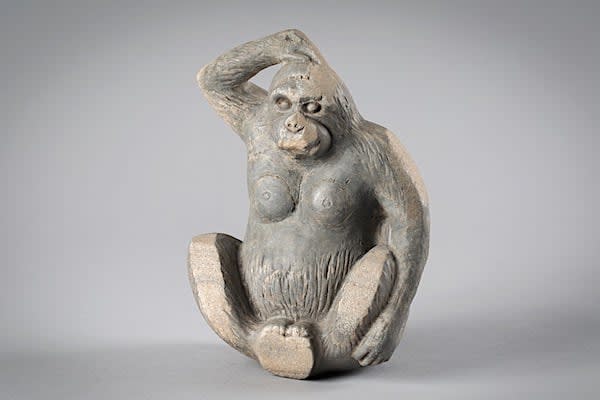Elamite Stone Figure of a Gorilla, 2100 BCE - 900 BCE
18 x 14 x 7 cm
7 1/8 x 5 1/2 x 2 3/4 in
7 1/8 x 5 1/2 x 2 3/4 in
CB.2967
Further images
Throughout the late prehistoric periods, Elam was closely tied culturally to Mesopotamia. Later, perhaps because of domination by the Akkadian dynasty (c. 2334–c. 2154 BCE), Elamites adopted the Sumero-Akkadian cuneiform...
Throughout the late prehistoric periods, Elam was closely tied culturally to Mesopotamia. Later, perhaps because of domination by the Akkadian dynasty (c. 2334–c. 2154 BCE), Elamites adopted the Sumero-Akkadian cuneiform script. Eventually Elam came under the control first of the Guti, a mountain people of the area, and then of the 3rd dynasty of Ur. As the power of Ur in turn declined, the Elamites reasserted their independence. In that turbulent period Elam’s unique system of matrilinear succession emerged; sovereignty was hereditary through women, in that a new ruler was always “son of a sister” of some member of an older sovereign’s family. About 1600 BCE new invaders of Mesopotamia, the Kassites, may have caused the fall of both Babylonia and Elam. Thereafter almost nothing is known of Elam until the latter part of the 13th century BCE, when it began reemerging as a substantial international power. The Elamite kings Shutruk-Nahhunte and Kutir-Nahhunte invaded Mesopotamia and succeeded in securing a large number of ancient monuments (such as the Victory Stele of Naram-Sin and the stele bearing the law code of Hammurabi). Shilkhak-In-Shushinak campaigned vigorously, and for at least a short period his domain included most of Mesopotamia east of the Tigris River and reached eastward almost to Persepolis. This greatest period of Elamite conquest ended when Nebuchadrezzar I of Babylon (reigned c. 1119–c. 1098 BCE) captured Susa. For almost 300 years thereafter nothing is known of Elamite history. In 640 BCE, however, the Assyrian king Ashurbanipal invaded Elam, sacked Susa, and deported some of the leading citizens to Samaria in Palestine. Later Elam formed a satrapy of the Persian Achaemenian dynasty, and Susa became one of the three most important cities of the Persian realm. Elam’s cultural accomplishments do not appear to have been extensive. Written business and governmental documents are limited in scope; still less is known of Elamite religious beliefs because no epic or religious materials in the Elamite language have been discovered. The language itself is not clearly understood and had no known ancient relatives and no modern descendants. Elam’s art and architecture clearly derived much of its inspiration from Babylonia. The temple complex and palace of Chogha Zanbil, along with its impressive ziggurat, are excellent remaining examples of Elamite culture.







